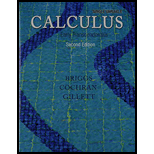
Concept explainers
The hailstone sequence Here is a fascinating (unsolved) problem known as the hailstone problem (or the Ulam Conjecture or the Collatz Conjecture). It involves sequences in two different ways. First, choose a positive integer N and call it a0. This is the seed of a sequence. The rest of the sequence is generated as follows: For n = 0, 1, 2, …
However, if an = 1 for any n, then the sequence terminates.
- a. Compute the sequence that results from the seeds N = 2, 3, 4, …, 10. You should verify that in all these cases, the sequence eventually terminates. The hailstone conjecture (still unproved) states that for all positive integers N, the sequence terminates after a finite number of terms.
- b. Now define the hailstone sequence {Hk}, which is the number of terms needed for the sequence {an} to terminate starting with a seed of k. Verify that H2 = 1, H3 = 7, and H4 = 2.
- c. Plot as many terms of the hailstone sequence as is feasible. How did the sequence get its name? Does the conjecture appear to be true?
Want to see the full answer?
Check out a sample textbook solution
Chapter 8 Solutions
Single Variable Calculus: Early Transcendentals & Student Solutions Manual, Single Variable for Calculus: Early Transcendentals & MyLab Math -- Valuepack Access Card Package
Additional Math Textbook Solutions
A First Course in Probability (10th Edition)
University Calculus: Early Transcendentals (4th Edition)
Elementary Statistics
Calculus for Business, Economics, Life Sciences, and Social Sciences (14th Edition)
- 2. Find a matrix A with the following qualities a. A is 3 x 3. b. The matrix A is not lower triangular and is not upper triangular. c. At least one value in each row is not a 1, 2,-1, -2, or 0 d. A is invertible.arrow_forwardFind the exact area inside r=2sin(2\theta ) and outside r=\sqrt(3)arrow_forwardA 20 foot ladder rests on level ground; its head (top) is against a vertical wall. The bottom of the ladder begins by being 12 feet from the wall but begins moving away at the rate of 0.1 feet per second. At what rate is the top of the ladder slipping down the wall? You may use a calculator.arrow_forward
- Explain the key points and reasons for the establishment of 12.3.2(integral Test)arrow_forwardUse 12.4.2 to determine whether the infinite series on the right side of equation 12.6.5, 12.6.6 and 12.6.7 converges for every real number x.arrow_forwarduse Cauchy Mean-Value Theorem to derive Corollary 12.6.2, and then derive 12.6.3arrow_forward
 Algebra and Trigonometry (MindTap Course List)AlgebraISBN:9781305071742Author:James Stewart, Lothar Redlin, Saleem WatsonPublisher:Cengage Learning
Algebra and Trigonometry (MindTap Course List)AlgebraISBN:9781305071742Author:James Stewart, Lothar Redlin, Saleem WatsonPublisher:Cengage Learning College AlgebraAlgebraISBN:9781305115545Author:James Stewart, Lothar Redlin, Saleem WatsonPublisher:Cengage Learning
College AlgebraAlgebraISBN:9781305115545Author:James Stewart, Lothar Redlin, Saleem WatsonPublisher:Cengage Learning College Algebra (MindTap Course List)AlgebraISBN:9781305652231Author:R. David Gustafson, Jeff HughesPublisher:Cengage Learning
College Algebra (MindTap Course List)AlgebraISBN:9781305652231Author:R. David Gustafson, Jeff HughesPublisher:Cengage Learning Elements Of Modern AlgebraAlgebraISBN:9781285463230Author:Gilbert, Linda, JimmiePublisher:Cengage Learning,
Elements Of Modern AlgebraAlgebraISBN:9781285463230Author:Gilbert, Linda, JimmiePublisher:Cengage Learning, Algebra for College StudentsAlgebraISBN:9781285195780Author:Jerome E. Kaufmann, Karen L. SchwittersPublisher:Cengage Learning
Algebra for College StudentsAlgebraISBN:9781285195780Author:Jerome E. Kaufmann, Karen L. SchwittersPublisher:Cengage Learning





